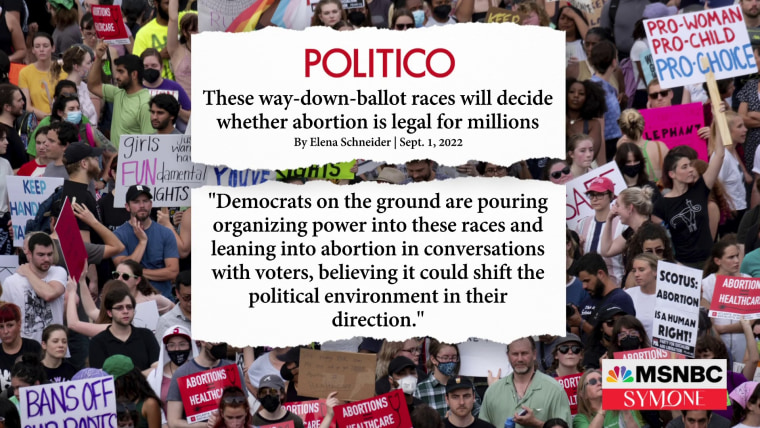In historical terms, the Democratic Party is beating the odds. The party in control of all the levers of power in Washington has closed a gap in generic congressional ballot polling that favored the GOP for most of Joe Biden’s presidency. Democratic candidates are winning special elections where they have no business even being competitive. Democratic aspirants for high office are outperforming their party’s unpopular president, who himself is enjoying a renaissance in his job approval ratings. It’s a heady experience for Democrats, who had all but resigned themselves to a brutal midterm election year, which helps explain why it’s all gone to their heads.
Come November, Democrats are still likely to find themselves on the receiving end of the voters’ wrath.
“Labor Day has come and gone and so have the prospects for a landslide Republican victory in November,” Democratic pollster Brad Bannon declared. “Republicans are no longer expected to score the big gains that would make a statement and strengthen their hand,” USA Today columnist Susan Page wrote of the emerging conventional wisdom. “The big red wave has crested and turned into a rising blue tide,” claimed Washington Post columnist Dana Milbank. Because “voters are receiving repeated reminders of what made them so unhappy in the Trump era,” he observed, “the big red wave looks to be more of a ripple.”
If they’re right and the red tide political forecasters long anticipated is receding because of former President Donald Trump’s sudden ubiquity on the national stage, Democratic fortunes are improving not as a result of the party’s actions but because of the designs of fate. And what the gods provide they can just as capriciously repossess. Moreover, even despite the Democratic Party’s political recovery, Republican candidates remain competitive and the GOP is favored to benefit most from the current political environment.
According to Real Clear Politics’ average of the generic ballot polling, which combines methodologies and smooths out individual polling’s margins of error, Americans favor Democrats by 0.5 percent. But that’s not the case at the level of the competitive districts that will decide which party secures a majority in the 118th Congress.
A late August CBS News/YouGov “battleground tracker” poll of voters in swing districts found Republicans enjoy the same 2-point advantage over Democrats they enjoyed in that poll in late July, and with fewer undecided voters left to convince. In other words, the GOP’s polling has remained stable in battleground races despite the alleged change in the Democratic Party’s fortunes. The forecasters at Decision Desk HQ still give the GOP an 81% chance of retaking the lower chamber of Congress. Five Thirty Eight is marginally less sanguine and says the GOP wins control in 74 out of 100 simulated 2022 elections.
The size of the Republican House margin varies by forecast, but it is as likely that the GOP will win a slim majority as it is likely that it will secure upward of 230 seats, a margin similar to the 235 seats Democrats won in 2018. Doubtless, the left will salve its wounds by claiming that Republicans underperformed expectations, but that’s cold comfort. The Democrats’ moral victory notwithstanding, the GOP will nevertheless control America’s purse strings.
What about the Senate? The amount of territory Republicans are defending after a surprisingly strong showing in 2016 ensured long ago that retaking the chamber in 2022 would be a struggle. The controversial candidates Republican primary voters preferred in states like Pennsylvania and Arizona, among others, haven’t made the National Republican Senatorial Committee’s job any easier.

But for all the flaws the GOP’s nominees bring to the race, both contests remain competitive. The latest Emerson College survey of the race in Arizona shows the incumbent, Sen. Mark Kelly, a Democrat, without majority support and with a meager 2-point lead over Republican Blake Masters. In Pennsylvania, Republican Mehmet Oz is benefiting from a tightening race against the Democrat, Lt. Gov. John Fetterman. Two recent polls of Pennsylvania’s likely voters from Susquehanna Polling and Research and Emerson College recently found that independent voters are starting to gravitate toward Oz as Fetterman’s lead has declined from double digits to just 4 and 5 points, respectively.
GOP candidates and incumbents in North Carolina, Florida and Ohio could fairly be said to be underperforming given their respective states’ Republican leanings, but the Republican candidates in those states have preserved modest but stable leads over their Democratic opponents. Sen. Ron Johnson of Wisconsin is as vulnerable today as he was in 2016. Given the shock of his re-election the last time around, however, the Badger State’s political prognosticators are keeping their powder dry. And Republicans aren’t the only ones defending vulnerable seats. In the last three polls of Georgia voters, Democratic Sen. Raphael Warnock slightly trails first-time Republican candidate Herschel Walker, despite Walker’s penchant for ponderous musings and gaffes.
Democrats could hold the line and preserve their control over the Senate, but Republicans have several pathways to the majority.
In Nevada and Colorado, unlike many other competitive states this year, Republican primary voters backed the most electable candidates in the primary field. They will face off against wounded incumbent Democrats, as will whomever New Hampshire Republicans choose to face Sen. Maggie Hassan. She exposes her vulnerability every time she leaps at the chance to distance herself from Biden, which is not infrequently. And all this assumes that the polling is capturing the universe of voters who are most likely to show up at the polls. As New York Times analyst Nate Cohen recently reminded his readers, capturing Republican voters, in particular, is a challenge the polling industry may not have fully resolved.
So where does that leave us? Democrats certainly could hold the line and preserve their control over the Senate, but Republicans have several pathways to the majority. A one- or two-seat GOP Senate majority is entirely conceivable.

If Republicans can overcome their summer doldrums, it will be in large measure because of the fundamentals of this election year. It is still the first midterm of a new president’s first term. Absent a truly anomalous event, the historical headwinds that accompany political power have proven reliably difficult for the party in control of Washington to overcome.
Most important, the economy remains voters’ primary concern, and Republicans own that issue. Democrats have done their best to talk up the economy — insisting that there has been “zero inflation” even as rents, groceries and energy costs continue to rise and touting the decline in gas prices that is driven primarily by falling demand for discretionary fuel purchases — but this campaign hasn’t had a measurable effect on voters’ impressions of the state of the economy or Biden’s handling of it.
Two months is a lifetime in politics. Unforeseen events will occur between now and November, some of which could upend the race. Of course, the investigation into Trump and the former president’s hunger for attention will continue to do the Republican Party no favors. But the “out party” isn’t as “out” as August’s headlines would lead you to believe. On the morning of Nov. 9, Americans are still more likely than not to awaken to news of a Republican rout.

